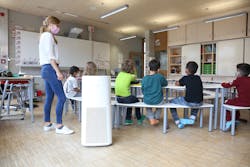Munich schools wheel out 7500 mobile UV-C units to combat coronavirus (UPDATED)
Back in the early days of the pandemic, Signify strikingly wasted no time ramping up disinfection lighting aimed at zapping the coronavirus in offices, homes, schools, and the like. But in the nearly two years that have followed, its announcements of large-scale deployments have been lacking.
While the company has disclosed ultraviolet C-band (UV-C) installations in stores, stadium locker rooms, and elsewhere, those examples have tended to be one-off and small in nature. The company had not publicly revealed any projects entailing thousands of units.
But that has now changed, as Signify has disclosed that the city of Munich has enlisted the use of 7500 mobile UV-C boxes in schools, where personnel are wheeling the units around classrooms to help keep the air clean of the SARS-CoV-2 virus that causes COVID-19. The mobile units from Signify rely on mercury-vapor lamps rather than UV-C LEDs.
Of course, Signify, like most companies, doesn’t announce every single sale. Far from it. It’s possible that it has other UV-C projects similar in scope to Munich.
So LEDs Magazine asked Signify if the Munich example is the company’s largest to date.
“It is the largest mobile unit project to date, both in Germany as well as globally,” a spokesperson replied via email.
We are awaiting a follow-up answer as to whether it is the largest of any description, including ceiling fixtures.
The previous biggest project that we recall was an installation of 280 Signify UV-C ceiling luminaires across the dm chain of drugstores in Slovakia.
Many other projects have numbered in the dozens of units. For example, an Amsterdam theater installed 75 upper air UV-C luminaires last summer, while another Dutch theater, in Someren, installed 20. An Edeka supermarket in Hamburg installed 31 upper-air–disinfecting luminaires. The PSV Eindhoven soccer team deployed 15 in a locker room.
In Munich, Signify is providing approximately 7500 of its Philips UVCA200 wheeled air disinfection units across the school system. The first 50 went to a school called Elementary school at Helmholtzstraße in September, which is spreading them around 12 rooms.
Delivery of the others has been continuing and “will wrap up shortly,” the spokesperson told LEDs. Signify declined to state how much it charged Munich for the products.
“In Germany, we were able to secure a bigger contract faster because there was government funding available to promote the use of air purification devices,” the spokesperson told LEDs.
It is not clear how many schools in total will use the devices.
“Especially during the flu season, continuous ventilation and disinfection in the classrooms is important,” said Munich school director Manuela Kirschenmann. “With the mobile units, a practical and effective solution has been found to help keep the air free of germs and viruses without restricting teaching.”
Soon after the world went into lockdown in the early months of 2020, Signify CEO Eric Rondolat signaled the company’s intentions to vigorously pursue UV-C products to combat the virus.
Within two months after that declaration, the company published a study by Boston University validating the effectiveness of Signify’s 254-nm mercury-vapor UV-C lamp at deactivating SARS-CoV-2, at certain doses. About a week after that, Signify announced it would develop a line of 12 different luminaires, boxes, and chambers designed to target the virus in the air, on surfaces, and on objects.
Signify has indeed now developed those and is planning more.
But despite the company’s ability to quickly escalate UV-C product offerings, market uptake appears to have dragged along below expectations.
Rondolat has over the last year twice described sales as a matter of an “education” for end users, first last February and then reiterating it last October, when he also revealed that the company was rejigging its approach to the UV-C market by emphasizing finished goods over OEM products. Last April, he referred to the UV-C business as “a marathon, not a sprint”.
It is possible that mobile units, which completely enclose UV-C emission — UV-C radiation is hazardous to humans if exposed — are now proving more appealing than ceiling luminaires, which require installation, and which are not completely enclosed, although they safely point UV-C upwards.
Signify is scheduled to post its fourth-quarter and year-end financial results this Friday, when more details on its UV-C efforts could emerge.
MARK HALPER is a contributing editor for LEDs Magazine, and an energy, technology, and business journalist ([email protected]).
*Updated Jan. 28, 2022 for clarification of mercury-vapor technology.
For up-to-the-minute LED and SSL updates, why not follow us on Twitter? You’ll find curated content and commentary, as well as information on industry events, webcasts, and surveys on our LinkedIn Company Page and our Facebook page.

Mark Halper | Contributing Editor, LEDs Magazine, and Business/Energy/Technology Journalist
Mark Halper is a freelance business, technology, and science journalist who covers everything from media moguls to subatomic particles. Halper has written from locations around the world for TIME Magazine, Fortune, Forbes, the New York Times, the Financial Times, the Guardian, CBS, Wired, and many others. A US citizen living in Britain, he cut his journalism teeth cutting and pasting copy for an English-language daily newspaper in Mexico City. Halper has a BA in history from Cornell University.



![The DesignLights Consortium continues to make progress in shifting outdoor lighting products and implementation practices toward a more restrained and thoughtful strategy. [Image does not represent a DLC qualified fixture.] The DesignLights Consortium continues to make progress in shifting outdoor lighting products and implementation practices toward a more restrained and thoughtful strategy. [Image does not represent a DLC qualified fixture.]](https://img.ledsmagazine.com/files/base/ebm/leds/image/2024/08/66be810888ae93f656446f61-dreamstime_m_265700653.png?auto=format,compress&fit=&q=45&h=139&height=139&w=250&width=250)

